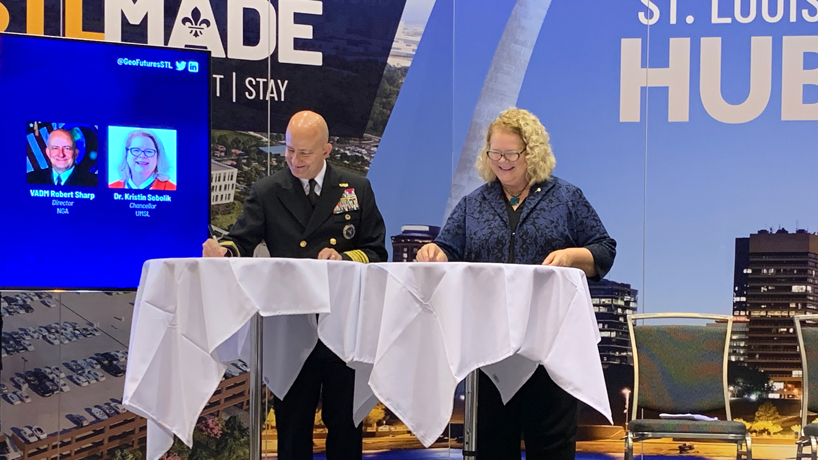
Former NGA Director Robert Sharp (at left), who joined UMSL Chancellor Kristin Sobolik in signing an Educational Partnership Agreement between UMSL and NGA last year, is joining the UMSL Geospatial Collaborative as a research fellow and will help guide efforts to lead collaborative K-16 workforce and talent development. (Photo courtesy of Jessica Daues/NGA)
The University of Missouri–St. Louis announced today that it has tapped retired Vice Admiral Robert Sharp, the former director of the National Geospatial-Intelligence Agency, to serve as a research fellow with the UMSL Geospatial Collaborative. In this new role, Sharp will help guide efforts to lead collaborative K-16 workforce and talent development while strengthening and expanding the university’s partnerships.
Robert Sharp spent 34 years working in naval intelligence, culminating in his three-year tenure at NGA, and has built a strong reputation for developing and motivating cohesive teams and working to solve complex problems.
“Bob is a proven leader in the geospatial field, and we are so pleased that we can continue to work with him as we grow our collective geospatial ecosystem in alignment with NGA as well as the region’s GeoFutures Strategic Roadmap guided by Greater St. Louis Inc.,” Chancellor Kristin Sobolik said.
UMSL Geospatial Collaborative
The UMSL Geospatial Collaborative is committed to helping develop the workforce pipeline that can support St. Louis’ rapidly growing geospatial sector, which has been catalyzed by construction of NGA’s new west campus near downtown.
“Just as the Taylor Geospatial Institute serves as a comprehensive hub for collaborative geospatial research, the Geospatial Collaborative at UMSL will serve as the central hub for building out the talent pipelines that will feed our growing geospatial sector for many years to come,” Sobolik said.
Sharp will also help UMSL faculty, staff and students leverage the power of geographic information systems – or GIS – for multi-disciplinary research and assist in their leadership development. Sharp is excited to have a role in building that future after retiring from his position as director at NGA in June.
“There are some truly amazing, ground-breaking initiatives underway as the city and region grows itself as the global hub for geospatial technology, research and talent, and I’m eager to be a part of these special efforts,” Sharp said. “I love where UMSL is putting its focus and resources because they are at the heart of my real passion – investing in our people and our partnerships.”
Alignment with GeoFutures Strategic Roadmap
“The St. Louis community continues to work together in unprecedented ways to implement the GeoFutures Strategic Roadmap with urgency every day so that we can reach our full potential as the global hub for geospatial technology. Workforce readiness is pillar of the Roadmap. No one is better suited to help St. Louis take our talent and workforce efforts to the next level than Bob Sharp. I’ve had the pleasure of getting to know him during his tenure at the NGA. He is not only a brilliant and inspiring leader, but he pairs that with an incredible compassion for people,” said Jason Hall, CEO of Greater St. Louis, Inc., of which GeoFutures is an initiative. “And under Chancellor Sobolik’s leadership, UMSL and its Geospatial Collaborative have become a cornerstone of our metro’s geospatial talent development needs.”
About Robert Sharp
Sharp, a native of San Jose, California, spent 34 years working in naval intelligence, culminating in his three-year tenure at NGA. Before that, he served as the commander of the Office of Naval Intelligence and the director of the National Maritime Intelligence-Integration office from April 2016 to February 2019 and spent time as director for intelligence at U.S. Special Operations Command.
He has decades of leadership experience in intelligence, defense and national security, and he’s built a strong reputation for developing and motivating cohesive teams and working to solve complex problems.
Sharp, who holds a bachelor’s degree in English from the University of the Pacific and a master’s degree in national resource strategy from the Industrial College of the Armed Forces, was instrumental in helping NGA meet the challenges brought on by the COVID-19 pandemic and use them as opportunities to reimagine and improve business processes that strengthened the agency and made it more agile.
His knowledge and experience can help enhance the work being done now across the region.
“The ongoing cooperation and collaboration in St. Louis between federal, state and local government, with business development leadership, industry partners, academia and non-profit organizations is unique and powerful,” he said. “It sets a model for others to emulate. The power that comes from bringing this collective together cannot be overstated. UMSL is well positioned to be not only a major participant, but an important leader in these collaborative efforts – especially as it relates to growing the talent and workforce of the future.”
UMSL Collaboration with NGA
Sharp joined Sobolik in October 2021 in signing an educational partnership agreement between NGA and UMSL to create a geospatial talent pipeline that will support student learning from kindergarten through college and beyond.
Under the educational partnership agreement, UMSL faculty and staff are working with NGA professionals to develop academic courses and programs in science, technology, engineering and mathematics that will provide students the knowledge and skills needed for careers in geospatial intelligence.
NGA subject matter experts also lend their expertise to UMSL faculty working to train K-12 educators in innovative teaching techniques that can help inspire future generations to study STEM and pursue STEM careers. There is a particular focus on reaching underrepresented student populations in line with the university’s commitment to inclusive growth and prosperity.
Last year, UMSL also signed a Collaborative Research and Development Agreement with NGA that is facilitating collaboration between UMSL researchers and the agency on geospatial research, training and other initiatives aimed at innovation. The UMSL Geospatial Collaborative is helping coordinate that work.
UMSL’s Geospatial Advanced Technology Lab
The university has been making investments in geospatial research including directing more than $1 million in funding from the state of Missouri through the Department of Higher Education and Workforce Development’s MoExcels program to build the Geospatial Advanced Technology Lab in Benton Hall. The project is still taking shape, but the lab will be outfitted with state-of-the-art computers with exceptional processing power and is expected to feature an extended virtual reality hub that will facilitate innovative research and enhance partnerships with regional and national businesses.
“UMSL is fully committed to this work and Bob is exactly the right person to not only help guide our geospatial focus given his background and passion for people,” Sobolik said, “but to also build meaningful collaborations and make substantial contributions to the burgeoning broader geospatial ecosystem led right here in St. Louis.”















